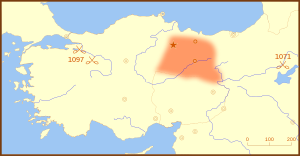Danischmenden
The dynasty of the Danischmenden , also Danischmendiden ( Turkish دانشمند , today Danişmentliler ), was a Turkmen ruling house in Anatolia in the 11th and 12th centuries . They were the main rivals of the Sultanate of Rum . The Danish Menden state was a Gazi state , a mercenary / warrior dictatorship, and not a monarchy like its Seljuk neighbors.
In the Danishmendname, an epic about Danischmend Ghazi , Battal Ghazi , who fought against Byzantium in the 9th century and whose deeds were described in the Battal-name , is referred to as the ancestor of the Danischmend.
history
The dynasty was founded by Danischmend Ghazi , who had the Persian title Danischmend , a term for a scholar. After the battle of Mantzikert (now Malazgirt ) in 1071, Danischmend Ghazi was awarded the city of Sivas as an Iqta . From here he conquered other Anatolian cities, including a. Amasya, Tokat and Kayseri.
He fought against the crusaders of the 1st crusade. In 1097 Kılıç Arslan I fought the Danischmenden at Melitene, while the Crusaders took advantage of his absence to conquer the Seljuk capital Nicaea . The Seljuks and the Danishmends then allied against the Crusaders, but were defeated by them in the Battle of Dorylaum .
In 1100 Danischmend captured Ghazi Bohemond of Taranto , who remained under his control until 1103. A Seljuk-Danish Mend alliance was also responsible for breaking off the crusade of 1101 , after the end of which Kılıç Arslan established his residence in Konya and resumed the fighting against the Danish Mends.
The Danishmends were probably in the fall of Kılıç Arslan's son I. Malik Shah involved. They reduced the Sultanate of the Rum Seljuks to Konya and its immediate vicinity.
In 1130 Bohemond II was killed by Antioch in a battle against the Danischmenden emir Gümüştekin . Gümüştekin was awarded the title of Malik by the Abbasid Haliph al-Mustarschid for his services in the fight against the Christians . He died in 1134. His successor Mohammed was weak; After his death in 1140 there were succession disputes between his sons and brothers and the Danish Menden Empire was defacto split into three parts (Kayseri, Malatya and Sivas).
In 1155 the Rum Seljuk Kılıç Arslan II attacked Yaghi-Bazan of Sivas, who sought help from Nur ad-Din , the Zengid- Emir of Mosul . Nur ad-Din conquered Maraş , Behesni and finally Sivas with troops from Malatya and with the support of the small Armenian ruler Mleh in 1173 , where he installed 'Abd-al-Massih, the former governor of Mosul, as administrator. But then he apparently came to an agreement with Kılıç Arslan II and retired to Damascus, where he died in May 1174. After his death, Kılıç Arslan II conquered Sivas in 1175 and Malatya in 1178, thus ending the rule of the Danischmenden.
Culture
In the 12th century, Danish-Manid coins bear both Arabic and Greek inscriptions.
List of rulers
- Danischmend Ghazi : 1097-1104
- Emir Ghazi Gümüştekin : 1104–1134
- Malik Mehmet Ghazi: 1134-1142
Branch in Sivas
- Malik Yaghi-Basan : 1142-1164
- Malik Mücahid Ghazi: 1164–1166
- Malik İbrahim: 1166-1166
- Malik İsmail: 1166–1166
- Malik Zünnun: 1172–1174
Branch in Malatya
- Ayn el-Devle: 1142-1152
- Zülkarneyn: 1152-1162
- Nasreddin Mohammed: 1162-1170
- Fahreddin: 1170-1172
- Afridun: 1172-1175
- Nasreddin Mohammed: 1175–1178 (second time)
literature
- Steven Runciman: A History of the Crusades (pp. 320-322), 1987 ISBN 0-521-34770-X
- Carter Vaughn Findley: The Turks in World history (Oxford 2005).
- Irene Melikoff: Dānishmendids in EI2
- Abüdlkerim Özaydın: Danişmendliler in TDV İA
- Clifford Edmund Bosworth: The New Islamic Dynasties , Edinburgh University Press 1996, pp. 215/216
- Ali Sevim: Türk Tarihi - Fetih, Selçuklu ve Beylikler Dönemi , Türk Tarih Kurumu 1989; P. 208ff
